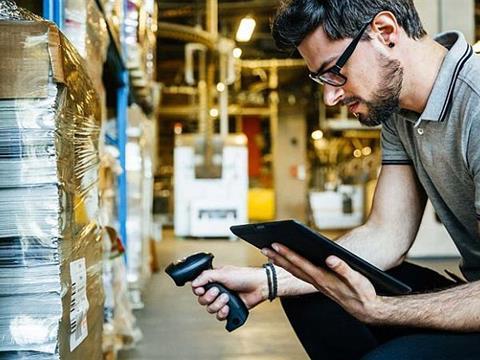
As a carrier of digital technologies, packaging offers promising options for improving logistics and production processes – how smart does it need to be to do this?
The VVL (Association for the Promotion of Innovative Logistics Solutions) tests and researches innovative packaging solutions and approaches for logistics planning. In the TechBox Forum at FachPack 2018, experts from the association's network talked about the wide range of options for making packaging intelligent using digital solutions. One such approach, for example, is the IntelliData Project, which is intended to discourage consumers from throwing away edible foodstuffs so indiscriminately in future.
Until now, those consumers daring enough to do so have relied on taste or smell to determine whether the milk in the fridge is still drinkable although the expiry date has passed or it has been opened for several days. The objective of a project led by QuoData GmbH is to develop an app that will be able to determine this accurately in future. However, it won’t be done using smell or taste but by means of a sensor label in or on the milk packaging, says Christian Bläul, IT Manager at QuoData. To do this the label determines certain variables that together can accurately determine whether the milk is still drinkable. In collaboration with the project’s partners, who represent the entire supply chain including the consumer, a prediction algorithm and sensor label are now being tested that do not impede the logistics and provide reliable use-by dates. Christian Bläul stressed that this system could also be adapted to other foodstuffs.
How intelligent does packaging need to be?
RFID chips on or in the packaging of a product, which share data and communicate with the environment, are what make this an intelligent packaging solution, explained Matthias Grzib, Project Manager IDH (Institute for Distribution and Trade Logistics) at the Association for Innovative Logistics Processes, during his presentation. In this context, the properties of smart products, Packaging 4.0 and intelligent packaging overlap – but they are not necessarily identical. A smart product is therefore a vital component of Industry 4.0. It needs to be able to communicate and interact with other stakeholders in the production chain. Matthias Grzib argues that packaging also needs to be regarded as a smart product and meet the requirements of Industry 4.0. Alongside its previous functions like product protection, marketing and handling, it performs other tasks, e.g. communicability, interconnectivity and the control of processes. If supplied with dynamic information on an RFID chip, intelligent packaging can turn a “normal” product into a smart product that was previously not suitable for the demands of Industry 4.0. For example, the packaging can then communicate from the warehouse with the manufacturer via appropriate readers and indicate which products that it can be used for.
According to Matthias Grzib, the benefit of intelligent packaging lies in the customer and product-specific choices it provides. Other advantages of intelligent packaging are optimum product protection, lower costs and self-organisation within the supply chain. As well as product packaging, this also includes a considerable amount of transport packaging, such as the plastic packaging produced by Walther Faltsysteme.
Reusable transport packaging with additional benefits
Thomas Walther, Managing Director of Walther Faltsysteme, introduced his presentation by pointing out that that in his view the dynamics of the smart factory still needed to be put into practice. However, for companies that are already incorporating these principles into their processes, Walther is already offering returnable containers with various smart functions. The plastic containers therefore meet the requirements imposed on intelligent information carriers. For example, RFID data carriers can be attached to a reusable container from the outside, or integrated into the material of the container or pallets.
In this context, the transport packaging always has to be suited to the relevant supply chain: it must be identifiable, controllable and ideally, also be able to communicate in future. Despite these wide-ranging requirements, the packaging manufacturer has to be capable of offering a durable and economic product that can provide and receive this kind of information. The great advantage is that information technology is becoming increasingly less expensive and therefore it is now much more feasible to implement the technology than it was ten years ago.
Intelligent reusable packaging can be used, for example, in commercial logistics. Thomas Walther also talked about its use in intelligent design, where simulations provide security throughout the complex development process – from the 3D CAD drawing to 3D printing pre-production and serial production.
3D printing of packaging
While rapid prototyping of packaging is already being realised with 3D printing, the further development of this application, i.e. printing the packaging in serial production, has not yet been economically viable. The progressive individualisation of packaging could change this in future, stressed Jörg Loges from VVL. Already, 3D printing can be worthwhile for product protection purposes, i.e. for the custom manufacture of special transport containers or packaging for valuable goods. Batch sizes are getting smaller and the packaging has to follow suit, stressed Loges, pointing to customised serial production in this context. At the moment, 3D printing is experiencing widespread use, as the technology is becoming more and more mature and cheaper. It is not possible to predict at the moment whether the technology will also be suitable for serial manufacturing. Nevertheless, 3D printing structures can produce a weight reduction and stability that was not previously possible.
Today packaging is already playing a major role in ensuring an exchange of information in production, logistics and commerce. The growing demand for individualised, safe and inexpensive products is continuing to drive the development of intelligent add-on functions. As a result, manufacturers increasingly have the opportunity to set their products apart from the competition through their packaging and to significantly improve their logistics processes. Once again, the exhibitors at FachPack in Nuremberg in September 2019 will offer solutions to these requirements.

















